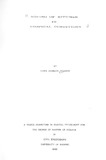| dc.description.abstract | The flexibility of asphaltic pavements diminishes as the bitumen binder ages. Consequently, surfacing failure occurs by cracking and disintegration under traffic loading. The deterioration of bituminous surfacing s early in their service life associated with the hardening of bitumen is a serious problem in the tropics.
A study into the in-service hardening of bitumen in low volume surface dressed test roads and high volume asphaltic concrete road sections under tropical climates was carried out. The surface dressed roads studied were test sections constructed and monitored by the Materials Branch of Ministry of Public Works of Kenya and Norwegian Road Research Laboratory. These sections were located on various low volume roads in different climatic zones of Kenya. Different types of aggregates and binders were used. On the other hand, asphaltic concrete road sections were of various ages along main highways chosen for this purpose.
During this study, bituminous surfacing samples were collected from both the test roads and asphaltic concrete road sections and physical and chemical investigations were carried out on recovered bitumen specimens. The results with the data obtained from the Materials Branch showed rapid but variable hardening of bitumen binders in the surface dressed sections in the first twenty months. The ductility decreased for most recovered bitumens from the test roads at three and above service years. The change in penetration of medium curing cutbacks (MC 3000) used in these sections was found to be a hyperbolic function of time, and the coefficient of determination, which
were 0.94 and above, indicated that the regression fittings were excellent.
The results also showed the variation of ageing with respect to the geographical location of the trial sections, and the types of binder and aggregates used in the trial sections. Me 3000 used at Marich Pass, Ndumberi, Kwale and Narok trial roads aged critically in five to six service years. Among the binders used in the trial sections, short
residue bitumens, MB 5000 and 200/500 pen, were found to be good ageing resistants. Binder ageing in sections where the laterite nodules were used was acute.
Unlike the thin surface test roads, ageing in asphaltic concrete surf'acin g s was highly associated with air voids content. In both cases, hardening was accompanied by high percentage of asphaltene fractions. The effect of binder hardening on the performance of the test roads was dependent upon the amount of traffic loading and the strength of the aggregates used. Surfacing failure on the test sections were by loss of ch ip pirig s , potholes and peel-offs while the high volume asphaltic concrete surfacings failed by cracking. | en |

